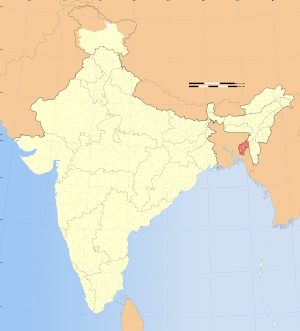Unakoti
| Unokoti | |
|---|---|
|
| |
 Unokoti Location in Tripura  Unokoti Location in Tripura | |
| Geography | |
| Coordinates | 24°19′N 92°4′E / 24.317°N 92.067°ECoordinates: 24°19′N 92°4′E / 24.317°N 92.067°E |
| Country | India |
| State | Tripura |
| District | Unakoti |
| Location | Kailasahar |
| History and governance | |
| Date built | 600-700 AD |
Unakoti hill, literally meaning, one less a koti in Bengali, hosts an ancient Shaivite place of worship with huge rock reliefs celebrating Shiva. It is the prime tourist spot of Unakoti Tripura District in the Kailashahar Subdivision in the North-eastern Indian state of Tripura.[1] It is Shaiva pilgrimage and dates back to 7th – 9th centuries if not earlier. The marvelous rock carvings, murals with their primitive beauty, waterfalls are not to be missed.
Description
It is a historic Shaiva pilgrimage spot and dates back to 7th – 9th centuries if not earlier. While the marvellous rock carvings, murals with their primitive beauty form the chief attraction, natural beauty including mountain scenery and waterfalls are an added bonus. As per Hindu mythology, when Lord Shiva was going to Kashi along with one crore gods and goddesses including him, he made a night halt at this location. He asked all the gods and goddesses to wake up before sun rise and proceed for Kashi. It is said that in the morning, except Shiva himself, no one else could get up so set out for Kashi himself cursing the others to become stone images as a result we have one less than a crore stone images and carvings at Unakoti.These carvings are located at a beautifully landscaped forest area with green vegetation all around which add to the beauty of the carvings.[2]
Iconography
The images found at Unakoti are of two types: namely rock-carved figures and stone images. Among the rock cut carvings, the central Shiva head and gigantic Ganesha figures deserve special mention. The central Shiva head known as Unakotiswara Kal Bhairava is about 30 feet high including an embroidered head-dress which itself is 10 feet high. On each side of the head-dress of the central Shiva, there are two full size female figures - one of Durga standing on a lion and another female figure on the other side. In addition three enormous images of Nandi Bull are found half buried in the ground. There are various other stone as well as rock cut images at Unakoti. Sidewise these statues is lush green grass and moss accompanied by beautiful waterfalls which are soothing to the eyes after walking through the small traffic and windy roads of hilly Kailashahar to reach there.
Festival
Every year a big fair popularly known as Ashokastami Mela is held in the month of April which is visited by thousands of pilgrims. Another smaller festival takes place in January. Apart from that tourists also flock to see this marvel of nature almost every other day from different parts of the country.
Location
Unakoti lies 178 km to the northeast from Agartala which has the closest airport, 8 km to the east from Kailashahar, district headquarters of North Tripura District, 148 km to the south-east from Silchar. The nearest railway station is about 20 km away at Kumarghat on the Lumding-Agartala line.
Preservation
The site has suffered centuries of neglect causing degradation and loss of considerable scale to the rock art. Since its adoption by the ASI (Archaeological Survey of India) as a heritage site, the situation has slightly improved, though a lot of work including substantial excavation remains to be undertaken.The government of India has approached to UNESCO to declare it as a world heritage site.[3] The Centre has recently granted Rs 12 crore to the state for developing the area, 178 km from here, as a major tourist destination.
Unakoti Myth
Once lord Shiva was going to Varanasi along with 1 crore god and goddesses including him. On the way they thought of taking rest and shelter on this hill for the night. Before going to bed Lord Shiva strictly warned the other gods and goddesses to get up at dawn before the sun rises and leave for Varanasi.The following morning only Lord Shiva got up and nobody else woke up. In anger Lord Shiva cursed them to become stone sculptures or images and stay there forever. Since then there have been one less than a crore stone sculptures on the hill.
According to the regional people at Unakoti, there was a sculptor & potter named Kallu Kumar. The local tribals believe that it was Kallu Kumar who had carved all these images and sculptures. He was a devotee of Parvati and wanted to accompany Shiva and Parvati to their abode on Kailash Parvat. On Parvati’s persuasion Shiva agreed to take Kallu to Kailash if he would sculpt a koti images of Shiva in one night. Kallu worked as a man possessed. But as the dawn broke the number of images was still one less than a koti. Shiva who was keen to get rid of this nuisance called Kallu, used this excuse to leave behind Kallu Kumar and his images at Unakoti.